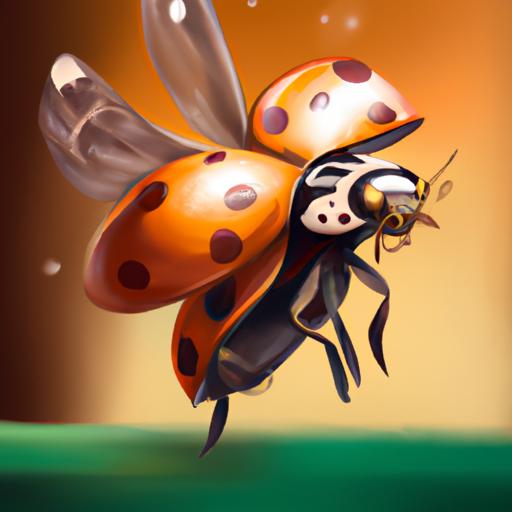Have you ever wondered where ladybugs live? These cute and curious creatures have been around for centuries, but where exactly do they call home? In this article, we will explore all you need to know about ladybug habitats.
From the conditions that make for the perfect home to the different species of ladybugs, you’ll learn the ins and outs of the tiny bugs’ living arrangements.
So let’s dive into the fascinating world of ladybugs and their habitats!
Where Does Ladybugs Live?
Ladybugs, also known as lady beetles or ladybird beetles, are a beloved insect species found all over the world.
There are over 5,000 species of ladybugs, with more than 450 native to North America.
They can live in a variety of habitats, from grasslands and forests, to deserts and mountains.
Most ladybugs prefer temperate climates, where the weather is mild and not too hot or cold.
These conditions allow them to survive through the winter and access the food and water they need to thrive.
Ladybugs are often found in areas with lots of vegetation, as they feed on small insects such as aphids, mites, and scale insects.
In addition to temperate climates, ladybugs can also be found in tropical areas.
As they are cold-blooded, they can survive in warmer climates and are often found in areas with lush vegetation and plentiful food sources.
Ladybugs will often collect in large numbers here, making the most of the insect sources available.
Ladybugs can also live close to humans, often in gardens and around homes.
They are beneficial to humans, as they help to control pest populations in gardens and on crops.
Ladybugs are attracted to bright colors and lights, so they can be found in areas with bright flowers or buildings.
No matter where ladybugs live, they are an important part of many ecosystems.
They help to control pest populations, provide food for other insects, and can even be a food source for animals.
Ladybugs are a much-loved species all over the world, and they are sure to continue bringing joy to our lives for many years to come.
What Do Ladybugs Eat?

Ladybugs, also known as lady beetles or Coccinellidae, are a type of small insect from the coleopteran family.
They are known for their bright red and black coloring, and they possess many beneficial attributes.
Ladybugs are beneficial because they eat a variety of garden pests such as aphids, mites, and other small insects that can cause serious damage to plants and crops.
Their main food sources are soft-bodied insects and their larvae, such as aphids, mealybugs, scale insects, leafhoppers, and thrips.
Ladybugs will also devour other insects like moths, beetles, and caterpillars.
Adults will also feed on pollen and nectar.
In the wild, ladybugs can be found hunting their prey on the leaves of plants in gardens and fields.
They will also congregate in large numbers to feed on larger infestations of soft-bodied insects.
Ladybugs have a strong sense of smell, which helps them detect their prey, and they use their antennae to find food.
In some cases, when food sources are scarce, ladybugs may even eat other ladybugs.
This is, however, a rare behavior and is only observed in extreme cases.
They can also eat the eggs of other insects and even the eggs of their own species.
Overall, ladybugs are incredibly beneficial and can help keep gardens and fields free of pests.
They feed on a variety of soft-bodied insects, pollen, and nectar, and in some cases, they may even feed on the eggs of other insects.
What Do Ladybugs Eat And Drink?
Ladybugs, also known as lady beetles or ladybird beetles, are small, oval-shaped insects with a bright, colorful shell.
Found on every continent except Antarctica, they are easily recognized by their distinctive black spots.
Ladybugs are important predators in the natural environment, as they feed on aphids, mites, and other small insects.
They also consume pollen, nectar, and honeydew secreted by aphids, as well as drinking water.
In the wild, ladybugs will form clusters on tree bark or other sheltered surfaces to overwinter.
When the weather warms in the spring, they will emerge and begin feeding on aphids and other insects in large numbers.
Ladybugs also perform other important functions in the environment, such as pollinating flowers and maintaining a balanced ecosystem.
Overall, ladybugs are beneficial insects that provide invaluable services to gardeners and farmers.
Not only do they eat pests, but they are also important pollinators.
Aphids, mites, pollen, nectar, and water are their primary sources of sustenance.
How Long Do Ladybugs Live?
Ladybugs, also known as ladybirds or lady beetles, can have lifespans ranging from a few weeks to up to a year.
This duration is determined by the species, the environment they live in, and the availability of food.
The usual lifespan for most common species of ladybugs is between 3 and 6 months.
During summer, they can live up to 9 months.
In rare cases, they can even survive for a year if they have access to enough food and the right environment.
In winter, ladybugs tend to hibernate, entering a state of dormancy that helps them get through the cold temperatures.
The length of the hibernation period depends on the species and typically occurs from October to April.
The environment is also an important factor in how long ladybugs live.
If it is too hot or too cold, ladybugs won’t be able to survive for long.
Thus, it is essential to maintain the right temperature and humidity levels to give them the best chance of survival.
Finally, the availability of food is a major influence on the lifespan of ladybugs.
They feed on aphids, which are tiny insects that live on plants.
Without a steady supply of food, they won’t be able to live for very long.
In conclusion, the lifespan of a ladybug depends on a variety of factors, including the species, environment, and food supply.
With the right conditions, they can live anywhere from a few weeks to up to a year.
Are Ladybugs Poisonous?

No ladybugs are not poisonous.
In fact, these beneficial insects also known as lady beetles or ladybird beetles are a gardener’s best friend.
They feed on aphids and other plant-eating pests, helping to keep your garden healthy and pest-free.
Ladybugs have two types of defensive chemicals they can use to protect themselves from predators.
When disturbed, they release a yellowish-orange fluid from their leg joints that has a foul odor and taste.
This helps keep predators away.
They also produce a noxious chemical called “reflex blood” if they are crushed, which gives off an unpleasant scent.
Both of these chemicals are harmless to humans and animals.
Ladybugs are also known for their bright colors, which act as a warning to predators that they are not edible.
While these vibrant colors may seem poisonous, they are just a warning sign that the beetle is not a tasty meal.
Ladybugs are an important part of the environment, helping to control aphid populations, and they are a welcome sight in many gardens.
To sum it up, ladybugs are not poisonous and can be a great addition to your garden.
Their bright colors are just a harmless warning sign to predators, and their defensive chemicals are not toxic to humans or animals.
Do Ladybugs Bite?
Ladybugs are one of the most beloved bugs to many people, and are often seen as symbols of good luck.
They rarely bite humans, as they are non-aggressive and harmless creatures belonging to the beetle family.
They have mouthparts called mandibles which they use to feed on small insects, pollen and nectar, but these are not strong enough to penetrate human skin.
Moreover, they have no venom, so they cannot inject any type of toxin into humans.
Although it is rare for ladybugs to bite humans, there are some situations in which it could occur.
For instance, if a ladybug is being handled roughly, it may bite as a reflexive response.
If a ladybug gets trapped in clothing, it may bite in an attempt to escape.
Additionally, some species of ladybugs may bite humans if they are hungry and cannot find any other food.
Overall, ladybugs are not a threat to humans and will generally not bite unless they are provoked or feel threatened.
If a ladybug does bite, it is not painful and will not cause any lasting harm.
What Do Ladybugs Need To Survive?
Ladybugs are a species of beetle which, like any living creature, need a food source, water, and shelter to survive.
These beneficial insects feed on pests such as aphids and other small insects, but also enjoy consuming pollen, nectar, and honeydew produced by plants.
Ladybugs are able to absorb moisture from the air and do not need to drink, though a small water source such as a shallow dish filled with pebbles and water can be beneficial.
As for shelter, a bush or tree, or even a man-made structure like a birdhouse, can provide them with a dark, sheltered place to hide during the day and be more active in the evening.
To attract and keep ladybugs in your garden, providing these basic elements is essential.
Final Thoughts
Ladybugs are fascinating creatures that live in all sorts of places, from the tops of trees to the middle of your garden.
Now that you know where they live and what they need to survive, you can help create a safe, comfortable environment for them in your own backyard.
With the right conditions and a little bit of luck, you may soon have a colony of ladybugs in your own backyard!

